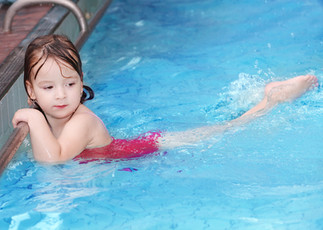Inside an Aquatic Therapy Session: A Step-by-Step Guide for Parents
- Pots
- May 31
- 2 min read
Discover how water becomes a powerful therapeutic environment for developing motor skills, sensory processing, and confidence.
Aquatic therapy offers a unique, supportive environment that can accelerate your child's development to complement and enhance land-based treatment. Here’s an insider’s view of what happens during aquatic therapy sessions.
The Aquatic Therapy Journey: What to Expect
Before Entering the Pool
Your aquatic therapy journey begins before even touching the water:
Initial assessment: Your therapist evaluates your child's current motor skills, sensory processing, and comfort level with water
Goal setting: Together with your therapist, you'll establish specific objectives for your child's aquatic therapy sessions
Pre- and post-pool routine: For children who need to establish or practice self-care skills like changing clothes, applying sunscreen, and showering, we incorporate them into the pool session
Entering the Water
The transition into the pool is carefully structured:
Comfortable Introduction: Children enter the water at their comfort level—some may start by playing alongside the water or on the steps, while others dive right in. We work with your child to establish a comfort level in the water at their own pace.
Therapeutic Activities: Your therapist engages your child in purposeful play that targets specific goals:
Buoyancy-supported movements reduce the effects of gravity, making challenging motor tasks more accessible
Resistance activities provide natural feedback that develops body awareness and strength
Rotational movements and position changes stimulate the balance system
Games requiring both sides of the body to work together reinforce important neurological connections
3. Guided Support: Throughout the session, your therapist provides hands-on guidance, clear verbal cues, visual demonstrations, and immediate feedback.
For many children, this structured entry process builds confidence and reduces anxiety about the pool.
Ending the Session
Transitioning out of the pool includes:
Calming activities prepare your child for returning to land
Achievements are celebrated to build confidence
Brief parent discussions help you understand progress and how to reinforce gains at home
Choosing ices or ice cream from our freezer!
Why Water is Often the Perfect Therapeutic Environment for Occupational Therapy Sessions
The unique properties of water make it exceptionally effective for therapy:
For Physical Development:
Buoyancy supports your child’s body, allowing some children to move in ways that they might not be able to on land
Even pressure improves body awareness by providing clear sensory boundaries
Resistance in all directions builds strength while providing consistent movement feedback
For Sensory Processing:
The deep pressure creates calming input
Moving through water provides vestibular stimulation in all planes of movement
The neutral warmth creates an optimal environment for calming and sensory regulation
Learning water safety requires mastering routines and sequences
The one-on-one environment often lends itself to increased focus and attention
For Emotional Growth:
Success in water builds confidence that transfers to land-based activities
The playful environment reduces anxiety about trying challenging tasks
Visible progress motivates continued effort and engagement

POTS Summer Aquatic Therapy Program
This summer, take advantage of our outdoor pool to inject novelty into your child's therapy program. Our specialized aquatic therapy sessions help children build strength, coordination, sensory processing, and self-care skills—all while feeling like play!
Sign up to learn how aquatic therapy can enhance your child's summer routine while building essential skills for success in daily life.






